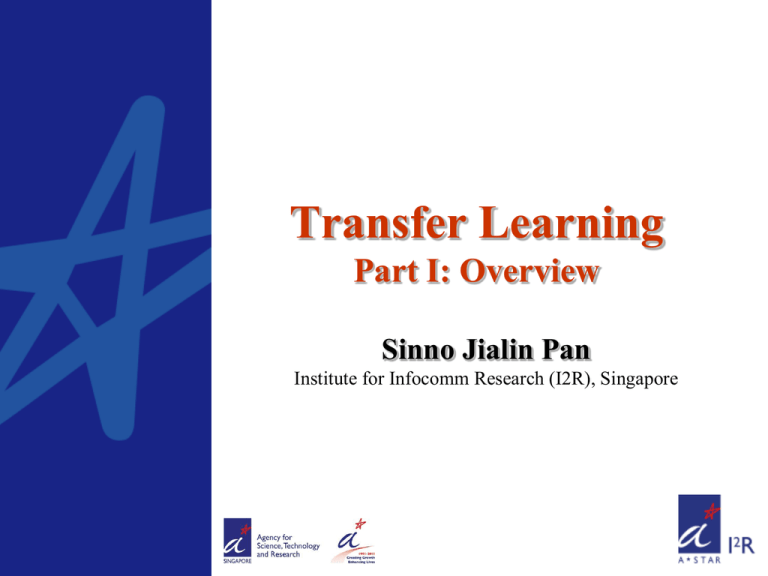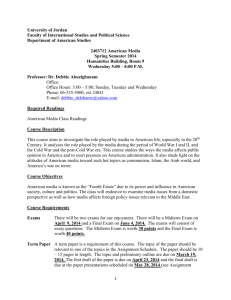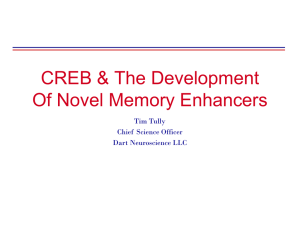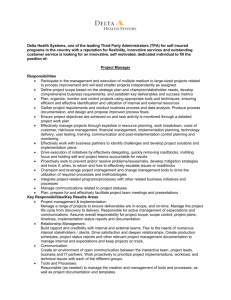Transfer Learning
advertisement

Transfer Learning Part I: Overview Sinno Jialin Pan Institute for Infocomm Research (I2R), Singapore Transfer of Learning A psychological point of view • The study of dependency of human conduct, learning or performance on prior experience. • [Thorndike and Woodworth, 1901] explored how individuals would transfer in one context to another context that share similar characteristics. C++ Java Maths/Physics Computer Science/Economics Transfer Learning In the machine learning community • The ability of a system to recognize and apply knowledge and skills learned in previous tasks to novel tasks or new domains, which share some commonality. • Given a target task, how to identify the commonality between the task and previous (source) tasks, and transfer knowledge from the previous tasks to the target one? Fields of Transfer Learning • Transfer learning for • Transfer learning for reinforcement learning. classification and regression problems. Focus! [Taylor and Stone, Transfer Learning for Reinforcement Learning Domains: A Survey, JMLR 2009] [Pan and Yang, A Survey on Transfer Learning, IEEE TKDE 2009] Motivating Example I: Indoor WiFi localization -30dBm -70dBm -40dBm Indoor WiFi Localization (cont.) Average Error Distance Training S=(-37dbm, .., -77dbm), L=(1, 3) S=(-41dbm, .., -83dbm), L=(1, 4) … S=(-49dbm, .., -34dbm), L=(9, 10) S=(-61dbm, .., -28dbm), L=(15,22) Test Localization model S=(-37dbm, .., -77dbm) S=(-41dbm, .., -83dbm) … S=(-49dbm, .., -34dbm) S=(-61dbm, .., -28dbm) ~1.5 meters Drop! Time Period A Time Period A Training S=(-37dbm, .., -77dbm), L=(1, 3) S=(-41dbm, .., -83dbm), L=(1, 4) … S=(-49dbm, .., -34dbm), L=(9, 10) S=(-61dbm, .., -28dbm), L=(15,22) Time Period B Test Localization model S=(-37dbm, .., -77dbm) S=(-41dbm, .., -83dbm) … S=(-49dbm, .., -34dbm) S=(-61dbm, .., -28dbm) Time Period A ~6 meters Indoor WiFi Localization (cont.) Average Error Distance Training S=(-37dbm, .., -77dbm), L=(1, 3) S=(-41dbm, .., -83dbm), L=(1, 4) … S=(-49dbm, .., -34dbm), L=(9, 10) S=(-61dbm, .., -28dbm), L=(15,22) Test Localization model Device A Device A Training S=(-33dbm, .., -82dbm), L=(1, 3) … S=(-57dbm, .., -63dbm), L=(10, 23) Device B S=(-37dbm, .., -77dbm) S=(-41dbm, .., -83dbm) … S=(-49dbm, .., -34dbm) S=(-61dbm, .., -28dbm) ~ 1.5 meters Drop! Test Localization model S=(-37dbm, .., -77dbm) S=(-41dbm, .., -83dbm) … S=(-49dbm, .., -34dbm) S=(-61dbm, .., -28dbm) Device A ~10 meters Difference between Tasks/Domains Time Period A Time Period B Device A Device B 8 Motivating Example II: Sentiment Classification Sentiment Classification (cont.) Classification Accuracy Training Test ~ 84.6% Sentiment Classifier Electronics Electronics Training Test Sentiment Classifier DVD Drop! ~72.65% Electronics Difference between Tasks/Domains Electronics Video Games (1) Compact; easy to operate; (2) A very good game! It is very good picture quality; action packed and full of looks sharp! excitement. I am very much hooked on this game. (3) I purchased this unit from (4) Very realistic shooting Circuit City and I was very action and good plots. We excited about the quality of the played this and were hooked. picture. It is really nice and sharp. (5) It is also quite blurry in (6) The game is so boring. I very dark settings. I will never am extremely unhappy and will buy HP again. probably never buy UbiSoft again. 11 A Major Assumption Training and future (test) data come from a same task and a same domain. Represented in same feature and label spaces. Follow a same distribution. The Goal of Transfer Learning Target Task/Domain Target Task/Domain Training A few labeled training data Training Electronics Classification or Regression Models Time Period A Device A Electronics Time Period A Device A Source Tasks/Domains Time Period B Device B DVD Notations Domain: Task: Transfer learning settings Heterogeneous Transfer Learning Heterogeneous Transfer Learning Feature space Homogeneous Tasks Identical Single-Task Transfer Learning Different Inductive Transfer Learning Focus on optimizing a target task Domain difference is caused by sample bias Domain difference is caused by feature representations Tasks are learned simultaneously Sample Selection Bias / Covariate Shift Domain Adaption Multi-Task Learning Tasks Identical Single-Task Transfer Learning Domain difference is caused by sample bias Domain difference is caused by feature representations Different Assumption Inductive Transfer Learning Focus on optimizing a target task Tasks are learned simultaneously Sample Selection Bias / Covariate Shift Domain Adaption Multi-Task Learning Single-Task Transfer Learning Case 1 Case 2 Sample Selection Bias / Covariate Shift Domain Adaption in NLP Instance-based Transfer Learning Approaches Feature-based Transfer Learning Approaches Single-Task Transfer Learning Case 1 Problem Setting Assumption Sample Selection Bias / Covariate Shift Instance-based Transfer Learning Approaches Single-Task Transfer Learning Instance-based Approaches Recall, given a target task, Single-Task Transfer Learning Instance-based Approaches (cont.) Single-Task Transfer Learning Instance-based Approaches (cont.) Assumption: Single-Task Transfer Learning Instance-based Approaches (cont.) Sample Selection Bias / Covariate Shift [Quionero-Candela, etal, Data Shift in Machine Learning, MIT Press 2009] Single-Task Transfer Learning Feature-based Approaches Case 2 Problem Setting Explicit/Implicit Assumption Single-Task Transfer Learning Feature-based Approaches (cont.) How to learn ? Solution 1: Encode domain knowledge to learn the transformation. Solution 2: Learn the transformation by designing objective functions to minimize difference directly. Single-Task Transfer Learning Solution 1: Encode domain knowledge to learn the transformation Electronics Video Games (1) Compact; easy to operate; (2) A very good game! It is very good picture quality; action packed and full of looks sharp! excitement. I am very much hooked on this game. (3) I purchased this unit from (4) Very realistic shooting Circuit City and I was very action and good plots. We excited about the quality of the played this and were hooked. picture. It is really nice and sharp. (5) It is also quite blurry in (6) The game is so boring. I very dark settings. I will am extremely unhappy and never_buy HP again. will probably never_buy UbiSoft again. 25 Single-Task Transfer Learning Solution 1: Encode domain knowledge to learn the transformation (cont.) Electronics Domain specific features Common features sharp compact good exciting Video game domain specific features realistic hooked never_buy boring blurry never_buy blurry boring exciting sharp compact good realistic hooked 26 Single-Task Transfer Learning Solution 1: Encode domain knowledge to learn the transformation (cont.) How to select good pivot features is an open problem. Mutual Information on source domain labeled data Term frequency on both source and target domain data. How to estimate correlations between pivot and domain specific features? Structural Correspondence Learning (SCL) [Biltzer etal. 2006] Spectral Feature Alignment (SFA) [Pan etal. 2010] 27 Single-Task Transfer Learning Solution 2: learning the transformation without domain knowledge Source Target Latent factors Temperature Signal properties Power of APs Building structure Single-Task Transfer Learning Solution 2: learning the transformation without domain knowledge Source Target Latent factors Temperature Signal properties Power of APs Cause the data distributions between domains different Building structure Single-Task Transfer Learning Solution 2: learning the transformation without domain knowledge (cont.) Source Target Noisy component Signal properties Building structure Principal components Single-Task Transfer Learning Solution 2: learning the transformation without domain knowledge (cont.) Learning by only minimizing distance between distributions may map the data to noisy factors. 31 Single-Task Transfer Learning Transfer Component Analysis [Pan etal., 2009] Main idea: the learned should map the source and target domain data to the latent space spanned by the factors which can reduce domain difference and preserve original data structure. High level optimization problem 32 Single-Task Transfer Learning Maximum Mean Discrepancy (MMD) [Alex Smola, Arthur Gretton and Kenji Kukumizu, ICML-08 tutorial] Single-Task Transfer Learning Transfer Component Analysis (cont.) Single-Task Transfer Learning Transfer Component Analysis (cont.) Single-Task Transfer Learning Transfer Component Analysis (cont.) [Pan etal., 2008] To minimize the distance between domains To maximize the data variance To preserve the local geometric structure It is a SDP problem, expensive! It is transductive, cannot generalize on unseen instances! PCA is post-processed on the learned kernel matrix, which may potentially discard useful information. Single-Task Transfer Learning Transfer Component Analysis (cont.) Empirical kernel map Resultant parametric kernel Out-of-sample kernel evaluation Single-Task Transfer Learning Transfer Component Analysis (cont.) To minimize the distance between domains Regularization on W To maximize the data variance Tasks Identical Different Problem Setting Single-Task InductiveTransfer TransferLearning Learning Domain differenceFocus is difference is caused on optimizing aDomain target task caused by sample bias by feature representations Tasks are learned simultaneously Inductive Transfer Learning Focus on optimizing a target task Tasks are learned simultaneously Assumption Sample Selection Bias Multi-Task Learning Domain Adaption / Covariate Shift Multi-Task Learning Inductive Transfer Learning Parameter-based Transfer Learning Approaches Modified from Multi-Task Learning Methods Self-Taught Learning Methods Target-Task-Driven Transfer Learning Methods Feature-based Transfer Learning Approaches Instance-based Transfer Learning Approaches Inductive Transfer Learning Multi-Task Learning Methods Parameter-based Transfer Learning Approaches Modified from Multi-Task Learning Methods Feature-based Transfer Learning Approaches Setting Inductive Transfer Learning Multi-Task Learning Methods Recall that for each task (source or target) Tasks are learned independently Motivation of Multi-Task Learning: Can the related tasks be learned jointly? Which kind of commonality can be used across tasks? Inductive Transfer Learning Multi-Task Learning Methods -- Parameter-based approaches Assumption: If tasks are related, they should share similar parameter vectors. Common part For example [Evgeniou and Pontil, 2004] Specific part for individual task Inductive Transfer Learning Multi-Task Learning Methods -- Parameter-based approaches (cont.) Inductive Transfer Learning Multi-Task Learning Methods -- Parameter-based approaches (summary) A general framework: [Zhang and Yeung, 2010] [Saha etal, 2010] Inductive Transfer Learning Multi-Task Learning Methods -- Feature-based approaches Assumption: If tasks are related, they should share some good common features. Goal: Learn a low-dimensional representation shared across related tasks. Inductive Transfer Learning Multi-Task Learning Methods -- Feature-based approaches (cont.) [Argyriou etal., 2007] Inductive Transfer Learning Multi-Task Learning Methods -- Feature-based approaches (cont.) Illustration Inductive Transfer Learning Multi-Task Learning Methods -- Feature-based approaches (cont.) Inductive Transfer Learning Multi-Task Learning Methods -- Feature-based approaches (cont.) [Ando and Zhang, 2005] [Ji etal, 2008] Inductive Transfer Learning Self-Taught Learning Methods Target-Task-Driven Transfer Learning Methods Feature-based Transfer Learning Approaches Instance-based Transfer Learning Approaches Inductive Transfer Learning Self-taught Learning Methods -- Feature-based approaches Motivation: There exist some higher-level features that can help the target learning task even only a few labeled data are given. Steps: 1, Learn higher-level features from a lot of unlabeled data from the source tasks. 2, Use the learned higher-level features to represent the data of the target task. 3, Training models from the new representations of the target task with corresponding labels. Inductive Transfer Learning Self-taught Learning Methods -- Feature-based approaches (cont.) Higher-level feature construction Solution 1: Sparse Coding [Raina etal., 2007] Solution 2: Deep learning [Glorot etal., 2011] Inductive Transfer Learning Target-Task-Driven Methods Assumption -- Instance-based approaches TrAdaBoost [Dai etal 2007] Main Idea For each boosting iteration, Intuition Part of the labeled data from the source domain can be reused after re-weighting Use the same strategy as AdaBoost to update the weights of target domain data. Propose a new mechanism to decrease the weights of misclassified source domain data. Summary Tasks Identical Single-Task Transfer Learning Feature-based Transfer Learning Approaches Instance-based Transfer Learning Approaches Different Inductive Transfer Learning Feature-based Transfer Learning Approaches Instance-based Transfer Learning Approaches Parameter-based Transfer Learning Approaches Some Research Issues How to avoid negative transfer? Given a target domain/task, how to find source domains/tasks to ensure positive transfer. Transfer learning meets active learning Given a specific application, which kind of transfer learning methods should be used. Reference [Thorndike and Woodworth, The Influence of Improvement in one mental function upon the efficiency of the other functions, 1901] [Taylor and Stone, Transfer Learning for Reinforcement Learning Domains: A Survey, JMLR 2009] [Pan and Yang, A Survey on Transfer Learning, IEEE TKDE 2009] [Quionero-Candela, etal, Data Shift in Machine Learning, MIT Press 2009] [Biltzer etal.. Domain Adaptation with Structural Correspondence Learning, EMNLP 2006] [Pan etal., Cross-Domain Sentiment Classification via Spectral Feature Alignment, WWW 2010] [Pan etal., Transfer Learning via Dimensionality Reduction, AAAI 2008] Reference (cont.) [Pan etal., Domain Adaptation via Transfer Component Analysis, IJCAI 2009] [Evgeniou and Pontil, Regularized Multi-Task Learning, KDD 2004] [Zhang and Yeung, A Convex Formulation for Learning Task Relationships in Multi-Task Learning, UAI 2010] [Saha etal, Learning Multiple Tasks using Manifold Regularization, NIPS 2010] [Argyriou etal., Multi-Task Feature Learning, NIPS 2007] [Ando and Zhang, A Framework for Learning Predictive Structures from Multiple Tasks and Unlabeled Data, JMLR 2005] [Ji etal, Extracting Shared Subspace for Multi-label Classification, KDD 2008] Reference (cont.) [Raina etal., Self-taught Learning: Transfer Learning from Unlabeled Data, ICML 2007] [Dai etal., Boosting for Transfer Learning, ICML 2007] [Glorot etal., Domain Adaptation for Large-Scale Sentiment Classification: A Deep Learning Approach, ICML 2011] Thank You






